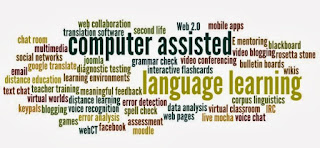The difficulties and Challenges
of Teachers’ Integrating Computer Assisted Instruction into Teaching.
(reference:
http://supawadeemooann.blogspot.com/)
1.ABSTRACT
This project aims to
investigate and discuss the effect of teacher’ integrating computer-assisted
instruction (CAI) and multimedia into teaching.
However, how to use
instructional technology to practice English teaching successfully and
efficiently is not an easy task. The instructors should understand the
development of CALL, the trends of instructional technology, and principles
applied in technology. In the study, during the process of teaching in the
computer-assisted environment, the teacher encountered numerous difficulties
and challenges from students' presentation, and assignments.
2.INTRODUCTION
With the change of times and
rapid development in technology, computer assisted language learning has become
a trend in resent years. Multiple multimedia has connected the new technology
education.
Recently, teachers' teaching
task is growing more and more different from that of the traditional teaching.
Teachers are not only instructors but also assistants to students' learning.
Now teachers should try to inspire students' potentials, and give them chance
of creative and critical thinking. The role of instructors in this modern
environment of CALL has become active, creative and innovative.
Every teacher should have
e-learning perception, computer technology training and then the teacher will
face new challenges to adopt new appropriate instructional strategies and to
facilitate student's learning. It is teachers' duty of how to put CAI into
practice that can bear the fruit of teaching and learning. Therefore, how to
apply computer assisted instruction into educational technology efficiently and
effectively is English language teachers’ main task (Wei, 2005).
3.LITERATURE REVIEW
The Brief History of Computer
Assisted Language Learning
In recent years, computers have
become so widespread in schools and homes that their uses have to be
re-examined. The development of CALL is divided into three main phases,
behaviorist CALL, communicative CALL, and integrative CALL.
Behaviorist CALL was the first
phase of computer assisted language learning implemented in the 1960 and 1970s.
The programs of this phase were based on then main behaviorist theories of
learning. Drill and practice courseware was based on the model of computer as
tutor (Taylor, 1980). A number of CALL tutoring systems were developed in the
era of the mainframe and the best-known tutorial system PLATO.
Communicative CALL based on the
communicative teaching approaches promoted communicative competence and real
communication. It appeared and became outstanding in the 1970s and early 1980s
(Underwood, 1984). Besides using computer as a tutor, computer should play the
role of a stimulus and a tool (Taylor, 1980). The former role adopted
communicative activities to encourage learners. And the latter role enabled
students to understand and use the language through word processing, spelling
and grammar checking desktop publishing programs (Warschauer, 1998).
Integrative CALL emerged in the
late 1980s and early 1990s based on multimedia computers and the Internet was
aimed to integrate the four skills (listening, speaking, writing and reading)
as well as technology in the language learning process (Warschauer &
Healey, 1998). For language students, they could involve themselves in their
learning in a more authentic learning environment by interesting all language
skills. It is thus not surprising the EFL will have get on the stage of CALL in
the future development.
4.Multimedia in the CALL
Classroom
Multimedia as a class of
computer-driven interactive communication systems which create, store,
transmit, and retrieve textual, graphic, and auditory networks of information.
Today’s multimedia is integrated into the CALL classroom. Multimedia allows a
variety of media such a texts, graphics, sound, animations, videos, and creates
various integrative language environments. The students can obtain the
multimedia resources and navigate their own path simply by pointing and
clicking the mouse
5.The Significance and Trends
of Instructional Technology
Instructional technology has
been defined as "applying scientific knowledge about human learning to the
practical tasks of teaching and learning" (Albion, 2001). Technology is
certainly a part of the landscape of society many people conclude that
technology logically should also play a key role in education. Educational
technology is especially important because teachers are eager to help students
reach high-level, worthwhile objectives, in the context of limited time and
resources. Along with technology and systematical design, teachers can make the
instruction more individualized, valid, accessible and economical (Wang, 2000).
So, instructors are to design
CALL lessons and seek appropriate media based on students need. Furthermore,
instructors are supposed to evaluate whether or not the instructional materials
are suitable for. Then computer assisted instruction (CAI) is an efficient way
to solve the instruction problems.
6.The Principles and Factors
are Applied in Technology
The common rationale for using
technology is based on two major points. According to societal inevitability
theory, technology is everywhere. And researches have been shown that using the
computer is efficient on education.
Applying computer technology makes
teachers have rich productivity, teaching effect, and change students learning
styles, which can make the relationship of interaction and connection between
teachers and students closely.
7.The Study
During the speaking and
listening course in CALL environment, the teacher set up E-learning campus.
Students had to post their assignments, watching other groups' report to give
their opinions and to correct each other's assignment, using e-mail, bulletin
board and chat room to exchange to obtain much more resource. Several items
were noticed:
1. Four or five students formed
a group in cooperative learning.
2. The teacher gave the
students a specific topic "A trip to a historic attraction and scenic
place", playing the CD Rom to motivate learning.
3. The teacher explained to
students how to search resources, connect related web-site, and showed students
to do procedure according to the task assigned
4. Each member in the group was
responsible for his own work then group discussed the assignment together and
brain stormed with each other to integrate their opinions to solve their
difficulties.
5. After discussing, each group
took a picture and video, modified the scripts and added music effect prepare
for their performance.
6. The students visited
traveler interviewed the employers of the stores, collected information and
recorded the viewpoint.
7. Each week the group students
posted their report and the group revised the report each other e-learning
campus.
8. The group students’
presented their product by video and power point.
9. The teacher and students
examined together.
8.DIFFICULTIES OF APPLYING
COMPUTER ASSISTED INSTRUCTION TO TEACHING
Applying the computer
technology in English class is so complicated and important that we don't
ignore it, but nowadays using CAI strategies is still not pervasive. Several
difficulties and challenges need be solved; several conditions have room to be
desired. The researcher analyzes as follows:
Facilities of the School and
Classroom
the computer classroom
difficult to use, and the administrator and the programmer had not enough time
to aid teachers in time. And mechanics were necessaries to maintain and remedy
computers
Related Administrators Emphasis
The biggest problem was lack of
the principle’s and the administrator's sufficient support. So teaching
practice in CALL was not easy to set into action.
Teachers' Teaching Beliefs and Styles
Teachers' aptitude and beliefs
play an important part. Whether teachers decide to apply computer technology
depends on their beliefs. So the teachers' attitude and beliefs influence
teaching and learning effect of the students (Fang, 1996)
Teachers' Computer Competence
In the course of the process of
teaching, teachers act as facilitators, designers, guides and assistants
(Warschauer, 1998). So teachers' technology competence should be enhanced. If
the teachers are lack of competence, such as computer multimedia contents
presented, systematic teaching models applied and multimedia sources utilized,
it is impossible for the teachers to integrate technology into teaching
efficiently (Wei,2005).
Teachers’ Heavy Burden
The teacher posted important
information on the bulletin board and reminded the students assignments and
test scores. The teacher always spent much time to deal with the computer
shutdown and contacted mechanics and programmers to repair the computer right
away.
Students’ Computer Competence
The teacher always found that a
lot of information students collected was copied, and posted. To raise learning
effect, enhancing students’ computer competence was urgent (Chien,2004).
8.THE SOLUTION THE PROBLEMS OF
APPLYING COMPUTER ASSISTED INSTRUCTION TO TEACHING
Computer Facilities and
Administrators' Emphasis
Adequate computer facilities
can facilitate teachers to use computer techniques and increase the
opportunities of teachers' applying technology to teaching.
Build up Teachers' Concept and
Teaching Beliefs
As long as teachers to are
willing to attempt to do it they will gain a lot of appropriate strategies of
technology teaching. Teachers' patience and perseverance are necessary ;
through such perseverance they can be able to elicit students' potential ability
in this computer instructional method.
Improve Teachers' and Students'
Computer Competence
When technology applied to
classroom instruction, teachers have to be familiar with the operation of the
computer.
Reduce Teachers' Workload
To reduce teachers' burden and
to enhance the effects of teaching. teachers should train students as group
leaders to aid them in their courses. In addition, teachers should have contact
with computer programmer closes and then teachers with programmer and group
leaders could maintain the operation and management of computer together.
In the age of integrating
technology into teaching, the teachers' task is both difficult and
challengeable, so teachers must take participate in related seminars,
conferences activities and practical lessons to seek for professional members
to solve difficult problems. Regular evaluations, strategies revised any time
are necessary for teachers to find the most appropriate and efficient methods
to help students reach the best learning outcomes.
9.Conclusion
This process of applying new
technology in English teaching is a challenge every English teacher will have
to face. Applying computer assisted language learning to teaching has become a
new trend to the advanced countries in the current world. Meanwhile,
information technology and multimedia teaching will be a direction that the
government advocates in our educational policy. Whether there integration
between technology and English teaching efficiently and successfully depends on
the teachers' efforts and professional abilities. More importantly, the
government and education authorities concerned should emphasis on the need of
information technology in schools, fostering the coordination of policy and
resources. Although the integration of technology into English is difficult and
complicated, it is suggested that teachers can build up confidence, and consult
with the professional teachers to continue innovation. It hoped that the
difficulties the teacher has faced in the study can serve as the future
reference for improving language learning strategies in college English
teachers.



ความคิดเห็น
แสดงความคิดเห็น